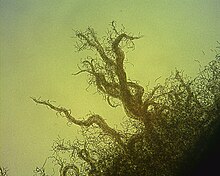Nitrogen fixation is a chemical process by which molecular dinitrogen is converted into ammonia. It occurs both biologically and abiologically in chemical industries. Biological nitrogen fixation or diazotrophy is catalyzed by enzymes called nitrogenases. These enzyme complexes are encoded by the Nif genes and contain iron, often with a second metal.

Cyanobacteria, also called Cyanobacteriota or Cyanophyta, are a phylum of autotrophic gram-negative bacteria that can obtain biological energy via oxygenic photosynthesis. The name "cyanobacteria" refers to their bluish green (cyan) color, which forms the basis of cyanobacteria's informal common name, blue-green algae, although as prokaryotes they are not scientifically classified as algae.
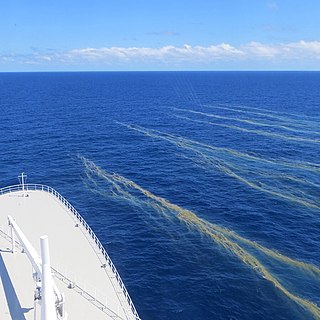
Trichodesmium, also called sea sawdust, is a genus of filamentous cyanobacteria. They are found in nutrient poor tropical and subtropical ocean waters. Trichodesmium is a diazotroph; that is, it fixes atmospheric nitrogen into ammonium, a nutrient used by other organisms. Trichodesmium is thought to fix nitrogen on such a scale that it accounts for almost half of the nitrogen fixation in marine systems globally. Trichodesmium is the only known diazotroph able to fix nitrogen in daylight under aerobic conditions without the use of heterocysts.

Heterocysts or heterocytes are specialized nitrogen-fixing cells formed during nitrogen starvation by some filamentous cyanobacteria, such as Nostoc, Cylindrospermum, and Anabaena. They fix nitrogen from dinitrogen (N2) in the air using the enzyme nitrogenase, in order to provide the cells in the filament with nitrogen for biosynthesis.
Diazotrophs are bacteria and archaea that fix atmospheric nitrogen (N2) in the atmosphere into bioavailable forms such as ammonia.

Anabaena is a genus of filamentous cyanobacteria that exist as plankton. They are known for nitrogen-fixing abilities, and they form symbiotic relationships with certain plants, such as the mosquito fern. They are one of four genera of cyanobacteria that produce neurotoxins, which are harmful to local wildlife, as well as farm animals and pets. Production of these neurotoxins is assumed to be an input into its symbiotic relationships, protecting the plant from grazing pressure.

Nostoc, also known as star jelly, troll's butter, spit of moon, fallen star, witch's butter, and witch's jelly, is the most common genus of cyanobacteria found in a variety of both aquatic and terrestrial environments that may form colonies composed of filaments of moniliform cells in a gelatinous sheath of polysaccharides. It may also grow symbiotically within the tissues of plants, providing nitrogen to its host through the action of terminally differentiated cells known as heterocysts. Nostoc is a genus that includes many species that are diverse in morphology, habitat distribution, and ecological function. Nostoc can be found in soil, on moist rocks, at the bottom of lakes and springs, and rarely in marine habitats. It may also be found in terrestrial temperate, desert, tropical, or polar environments.
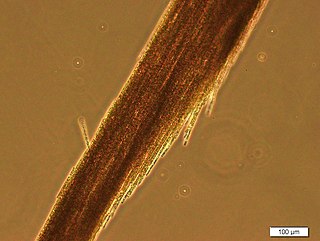
Aphanizomenon flos-aquae is a brackish and freshwater species of cyanobacteria of the genus Aphanizomenon found around the world, including the Baltic Sea and the Great Lakes.

Anabaena circinalis is a species of Gram-negative, photosynthetic cyanobacteria common to freshwater environments throughout the world. Much of the scientific interest in A. circinalis owes to its production of several potentially harmful cyanotoxins, ranging in potency from irritating to lethal. Under favorable conditions for growth, A. circinalis forms large algae-like blooms, potentially harming the flora and fauna of an area.

An akinete is an enveloped, thick-walled, non-motile, dormant cell formed by filamentous, heterocyst-forming cyanobacteria under the order Nostocales and Stigonematales. Akinetes are resistant to cold and desiccation. They also accumulate and store various essential material, both of which allows the akinete to serve as a survival structure for up to many years. However, akinetes are not resistant to heat. Akinetes usually develop in strings with each cell differentiating after another and this occurs next to heterocysts if they are present. Development usually occurs during stationary phase and is triggered by unfavorable conditions such as insufficient light or nutrients, temperature, and saline levels in the environment. Once conditions become more favorable for growth, the akinete can then germinate back into a vegetative cell. Increased light intensity, nutrients availability, oxygen availability, and changes in salinity are important triggers for germination. In comparison to vegetative cells, akinetes are generally larger. This is associated with the accumulation of nucleic acids which is important for both dormancy and germination of the akinete. Despite being a resting cell, it is still capable of some metabolic activities such as photosynthesis, protein synthesis, and carbon fixation, albeit at significantly lower levels.
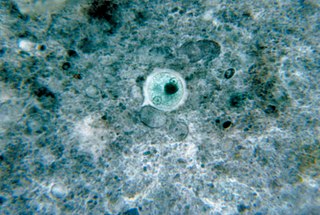
A microbial cyst is a resting or dormant stage of a microorganism, that can be thought of as a state of suspended animation in which the metabolic processes of the cell are slowed and the cell ceases all activities like feeding and locomotion. Many groups of single-celled, microscopic organisms, or microbes, possess the ability to enter this dormant state.
Cyanobionts are cyanobacteria that live in symbiosis with a wide range of organisms such as terrestrial or aquatic plants; as well as, algal and fungal species. They can reside within extracellular or intracellular structures of the host. In order for a cyanobacterium to successfully form a symbiotic relationship, it must be able to exchange signals with the host, overcome defense mounted by the host, be capable of hormogonia formation, chemotaxis, heterocyst formation, as well as possess adequate resilience to reside in host tissue which may present extreme conditions, such as low oxygen levels, and/or acidic mucilage. The most well-known plant-associated cyanobionts belong to the genus Nostoc. With the ability to differentiate into several cell types that have various functions, members of the genus Nostoc have the morphological plasticity, flexibility and adaptability to adjust to a wide range of environmental conditions, contributing to its high capacity to form symbiotic relationships with other organisms. Several cyanobionts involved with fungi and marine organisms also belong to the genera Richelia, Calothrix, Synechocystis, Aphanocapsa and Anabaena, as well as the species Oscillatoria spongeliae. Although there are many documented symbioses between cyanobacteria and marine organisms, little is known about the nature of many of these symbioses. The possibility of discovering more novel symbiotic relationships is apparent from preliminary microscopic observations.

Phototaxis is a kind of taxis, or locomotory movement, that occurs when a whole organism moves towards or away from a stimulus of light. This is advantageous for phototrophic organisms as they can orient themselves most efficiently to receive light for photosynthesis. Phototaxis is called positive if the movement is in the direction of increasing light intensity and negative if the direction is opposite.
Raphidiopsis raciborskii is a freshwater cyanobacterium.

Nostoc punctiforme is a species of filamentous cyanobacterium. Under non-limiting nutritional environmental conditions, its filaments are composed of photosynthetic vegetative cells; upon nutrient limitation, some of these cells undergo differentiation into heterocysts, akinetes or hormogonia.

Cyanothece is a genus of unicellular, diazotrophic, oxygenic photosynthesizing cyanobacteria.
Some types of lichen are able to fix nitrogen from the atmosphere. This process relies on the presence of cyanobacteria as a partner species within the lichen. The ability to fix nitrogen enables lichen to live in nutrient-poor environments. Lichen can also extract nitrogen from the rocks on which they grow.
Richelia is a genus of nitrogen-fixing, filamentous, heterocystous and cyanobacteria. It contains the single species Richelia intracellularis. They exist as both free-living organisms as well as symbionts within potentially up to 13 diatoms distributed throughout the global ocean. As a symbiont, Richelia can associate epiphytically and as endosymbionts within the periplasmic space between the cell membrane and cell wall of diatoms.
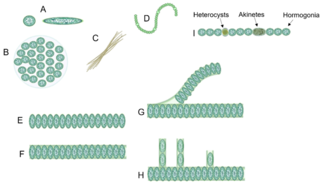
Cyanobacterial morphology refers to the form or shape of cyanobacteria. Cyanobacteria are a large and diverse phylum of bacteria defined by their unique combination of pigments and their ability to perform oxygenic photosynthesis.
Aphanizomenon ovalisporum is a filamentous cyanobacteria present in many algal blooms.
